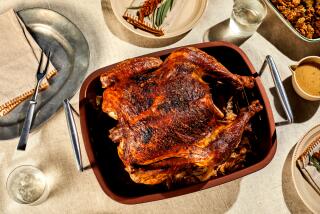Is It Done Yet?
- Share via
New breeds of turkey are cooking quicker than birds sold just a few years ago, according to the Department of Agriculture. As a result, the USDA’s Food Safety and Inspection service recommends slightly different roasting times for whole turkeys than it has in years past.
In fact, doneness should be judged by the turkey’s internal temperature rather than by the clock, says the agency, which is responsible for the safety and wholesomeness of meat and poultry.
Harmful bacteria that may be present in raw poultry are effectively destroyed at 160 degrees. But when one portion of the turkey is at 160 degrees, the rest of the bird may not be. For that reason, the USDA recommends that a meat thermometer be inserted in the thickest part of the thigh--normally the last part of the turkey to cook--and read 180 degrees to ensure that all parts of the turkey are done.
Although you shouldn’t rely on cooking times as an indicator of doneness, the USDA has developed the following rough guidelines to help you determine how long it should take your turkey to get to the desired temperature. Because of changes in turkey breeding, these times are as much as 45 minutes faster than previous recommendations.
Unstuffed Weight Roasting Time
8 to 12 pounds--2 3/4 to 3 hours
12 to 14 pounds--3 to 3 3/4 hours
14 to 18 pounds--3 3/4 to 4 1/4 hours
18 to 20 pounds--4 1/4 to 4 1/2 hours
20 to 24 pounds--4 1/2 to 5 hours
*
Stuffed Weight Roasting Time
8 to 12 pounds--3 to 3 1/2 hours
12 to 14 pounds--3 1/2 to 4 hours
14 to 18 pounds--4 to 4 1/4 hours
18 to 20 pounds--4 1/4 to 4 3/4 hours
20 to 24 pounds--4 3/4 to 5 1/4 hours
* More information about the new cooking times is available toll-free from the USDA’s Meat and Poultry Hotline at (800) 535-4555.
More to Read
Sign up for Essential California
The most important California stories and recommendations in your inbox every morning.
You may occasionally receive promotional content from the Los Angeles Times.








